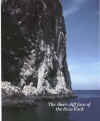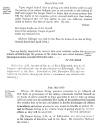|
The Bass
Rock
The Bass
Rock lies about two miles off the North Berwick coast
although it looks closer, and is opposite the ancient
castle of Tantallon.

Today it is a well known sea bird sanctuary with a large
colony of about 100,000 gannets, but it has a much darker past as a
singularly desolate prison for many of the Covenanter
leaders between 1673 and 1687. The
Bass, dedicated to St Baldred (who
is said to have died there, 6th
March 606), was united to the Parish of North
Berwick in 1581.
A curious remnant of
old ecclesiastical privilege
still exists twelve
solan geese with the feathers on being annually
paid to the
minister of North Berwick as “Vicar of the
Bass.”
The island at one time
belonged to Sir Andrew Ramsay, Provost of Edinburgh who saw the opportunity of profit when a place to lock up Covenanter prisoners was needed.
He had been a member of a committee that had considered what might
be done to prevent conventicles and punishing persons who withdrew from
the parish church ordinances. At this time ( March 1671) the government
was in need of a prison for the growing number of Covenanters being taken
into custody. One version is that the Bass was part of the estate of
Waughton, near North Berwick and that Ramsay came to ownership through
marriage to the heiress. Another version is that he bought the island for £400 and convinced Lauderdale, Secretary of State for Scotland, that it would be a suitable place for a prison. He sold it for £4000
probably with the hope that he might be made the salaried Governor of the
prison. Lauderdale had
it turned into a prison which was to house 39 Covenanters
in extremely tough conditions.
 The The
Bass Rock is itself only about three quarters of a mile in
circumference with sheer cliffs on three sides rising to
over 300 feet, on the fourth is a narrow and dangerous
landing point. Even on calm days the seas swell and roll
round the island with a dangerous tidal flow between it
and the mainland – not a place to attempt escape by
swimming. On the island, once a retreat for a Welsh monk
in the seventh century, there was little shelter until the
building of the prison quarters and a Governor’s house,
which in heavy seas would be awash. Some of the cells had
only one small window which was out of reach of the
prisoner – who was therefore unable to view the outside.
Other cells looked only upon a paved walkway where the
soldiers stood guard. There was, too, a dark, dank dungeon
– the Black Hole. Into
the Bass were cast many of the more troublesome
Covenanters for periods ranging from a few months to years
including John Dickinson who had two visits to the
Edinburgh Tolbooth and then spent nearly seven years as a
prisoner on the Bass Rock. A prominent lay man – who was
the last prisoner to leave the Bass in 1687, was
John Spreul, apothecary of
Glasgow who suffered greatly for his conscience. Being
well off by the standards of the time, he was a special
target of the grasping oppressors.

There has
been some debate over the years who exactly was imprisoned
on the Bass. One would expect that the Rev John Blackadder
(who died there) would have a good idea who his companions
were and gives one list in his `Memoirs`. It is, however,
generally accepted that the list of the Rev. James
Anderson, contributor to McCries “The Bass Rock: Its
Civil and Ecclesiastical History“ (1847) is nearest
the mark (he rejected twelve of Blackader`s list). The
Anderson list, cited in Johnstons Treasury is:
|
George Scot of Pitlochie
|
Robert Bennet of Chesters
|
|
Alexander Gordon of Earlston
|
Sir
Hugh Campbell of Cessnock
|
|
Sir
George Campbell of Cessnock
|
Rev
James Fraser of Brea
|
|
Rev
John Blackader of Troqueer
|
Rev
Patrick Anderson, Walston
|
|
Rev
John Campbell, Ireland
|
Rev
John Dickson, Rutherglen
|
|
Rev
James Drummond, chaplain to Marchioness of Argyl
|
Rev
James Fithie, Chaplain, Trinity Hospital, Edinburgh
|
|
Rev
Alex Forrester, St Mungo
|
Rev
John Grieg, Carstairs
|
|
Rev
Thomas Hog, Kiltearn
|
Rev
Peter Kid, Carluke
|
|
Rev
John Law, Campsie
|
Rev
John McKilligan, Fodderty
|
|
Rev
Alexander Peden, New Glenluce
|
Rev
John Rae, Symington
|
|
Rev
Archibald Riddell, Kippen
|
Rev
Gilbert Rule, Prestonhaugh
|
|
Rev
John Stewart, Deer
|
Rev
Robert Traill, Cranbrook
|
|
Rev
Thomas Ross, in the North
|
William Bell, preacher.
|
|
Alexander Dunbar, preacher.
|
Robert Gillespie,preacher.
|
|
James
Macaulay, preacher
|
James
Mitchell, preacher.
|
|
Michael Potter, preacher.
|
Robert Ross, preacher.
|
|
Alexander Shields, preacher.
|
William Spence, schoolmaster, Fife.
|
|
Major
Joseph Learmont, Army
|
William Lin, Writer in Edinburgh.
|
|
John
Spreul, Town Clerk of Glasgow.
|
John
Spreul, apothecary in Glasgow.
|
|
Robert Dick, Saltgrieve to Lord Carington.
|
|
The transfer of John Law, John Dickinson(e), Francis Irving, Robert Gillespie to the Bass. is recorded in the records pf the Edinburgh Tolbooth, along with Alexander Peden on his capture in England, and latterly Alexander Shields (Shiells). Extracted from The Book of the Old Edinburgh Club Vol VI. Another record is that of Alexander Riddell, a noted conventicle preacher (Vol VIII)



Blackness
Castle Dunnottar Castle
Greyfriars Kirk Yard
|